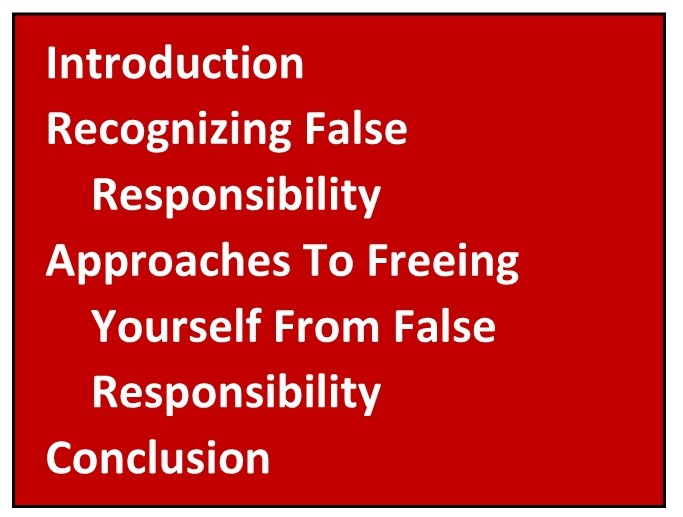Ending False Responsibility
INTRODUCTION
In the Letters on responsibility (beginning with the April Letter) we started with a definition of responsibility and pointed out the benefits of taking responsibility. In using the word responsibility we were referring to accountability. We moved onto exploring what false responsibility is and its destructive effects. In this Letter we describe how to identify the false responsibility that you have taken on and how to free yourself from it.
As we explore false responsibility let’s keep in mind this general principle about life. We are always responsible for our reactions to events. No one causes us to feel our feelings though certain feeling reactions seem normal and “perfectly appropriate.” The behavior of other people may trigger a response from us but that response whether appropriate or inappropriate, weak or strong, useful or dysfunctional, always belongs to us. At one time or another everyone blames someone else for the way we feel. Blaming other people for the way we feel is almost a human tendency.
Point of Empowerment: We are always responsible for our reactions to an event in our life because our reactions belong to us alone. We own them.
Point of Empowerment: What we own comes under our control and our will. What comes under our control and our will, we have a choice about. Where we have choice is where our freedom lies.
In this Letter we consider effective responses to the two causes of false responsibility described in the August Letter along with additional causes and approaches to free ourself of false responsibility.
RECOGNIZING FALSE RESPONSIBILITY
To identify when you are taking on false responsibility understand what it is, become aware of the situations where you are taking on false responsibility, and recognize when you are experiencing the consequences of taking on false responsibility. These aspects of false responsibility are outlined in the August Letter.[i]
Remember that you may feel frustrated, anxious, depressed, angry, unhappy, sad, and confused as you take on false responsibility. Tune into these feelings as you look for the situations where you take on false responsibility. Strive to feel better by freeing yourself from this burden. As you tune into your feelings is there a pain that does not go away no matter what you do. You have taken ownership of something that does not belong to you. You will feel this pain until you refuse ownership of the thing that does not belong to you. (Pain that does not go away may also have other causes, like the pain from unmet childhood needs or trauma.)
We can also think in terms of what, when, and how: what have you taken false responsibility for, when did you take on this responsibility, and how did this responsibility become yours. What refers to the specifics of the responsibility. When relates to childhood, adolescence, or adulthood. And how asks if this responsibility came to you from another person or did you take it on yourself, was it self initiated.
APPROACHES TO FREEING YOURSELF FROM FALSE RESPONSIBILITY
The general approach to freeing yourself from false responsibility is to recognize that you have accepted false responsibility and say, “No, I do not own this therefore it is not my responsibility. I refuse it.” Also, experiencing false responsibility is caused by holding beliefs that bring this about. Whether it is blame that comes from someone else or self initiated false responsibility, beliefs are involved. Freeing yourself involves identifying and examining the beliefs that cause false responsibility and changing them. To change a belief, state the belief then state the affirmation, “No I no longer hold this belief. I now believe”. . . and state your new belief. Do this until you find yourself accepting and acting on the new belief. (A full discussion about identifying and change beliefs is in the February through July 2018 Letters for Insight and Innovation.[ii])
Point Of Empowerment: To free yourself from false responsibility say no and change the belief.
Let’s go through the what, when, and how of accepting false responsibility seeing how to free ourselves in each situation by examining the beliefs and saying no. Attaining freedom can be easy, somewhat difficult, or difficult.
Blame. Consider false responsibilities that occur because someone else has blamed you, giving you responsibility for something that does not belong to you. And, you have accepted this blame by agreeing that something is your fault. This can occur in childhood, adolescence, and adulthood. This can occur frequently in childhood due to the vulnerabilities of childhood which come from the child’s limitations of his/her abilities to understand how the world works and because of a child’s dependency on the adults in his/her life. These vulnerabilities can be brought into adolescence and adulthood. They can combine with another person’s forcefulness and aggression or their skill at manipulating with fear, guilt, and shame to induce false responsibility.
Underlying all acceptance of blame, of false responsibility, is the child’s belief that everything that happens to him/her and everything that happens in the world is his/her fault. That we cause everything is a belief in our omnipotent (all powerful) control of the world. This belief in our control is truly a child’s belief that to some degree everyone carries into adulthood. Change this belief to, “There are things that I can control through my actions and things that I have no control over.” State, “I refuse responsibility for things I have no control over.”
Recognize and reject the blame and responsibility giving to you by someone else. State, “I see that you have made me responsible for this situation. Since I did not cause it or have any control over it I reject the responsibility.”
Self-Initiated. These are false responsibilities that we have taken on by our own actions. These are situations where we believe we are at fault, where we believe that we caused the situation but we did not. We blame ourselves. This can occur in childhood, adolescence, and adulthood. In childhood self initiated false responsibility occurs because of the child’s self-centeredness—“I am the cause of everything in my world,” and fearful dependency—“It is too scary to face my parents limitations, it is better to think that I am at fault.”
We stop taking on these responsibilities by changing the belief that we caused the situation. Changing this belief can be easy, difficult, or very difficult. Beliefs about simple situations can be easy to change. Beliefs about complex situations can be very difficult to change. Here are some examples.
- I caused my parent’s divorce. I am responsible.
- I killed my sick parent due to my misbehavior. I am responsible.
- All of my sibling’s unhappiness and anger, especially anger at me, must be due to the incident where I pushed him/her and he/she broke an arm. I am responsible.
Practice: Identify the situation and the belief about causation. Research the real cause. Move out of false and into real causation.
- I did not cause my parent’s divorce. It was their own inability to resolve conflict that lead to their divorce. I am not to blame.
- My behavior might have stressed my sick parent, but his/her death was caused by the illness. I am not to blame.
- My sibling’s frequent upset feelings were not caused by anything I did but by his/her own difficulties in life. I am not to blame.
Distorted beliefs. These are beliefs that seem true but are not. Beliefs give rise to expectations. When expectations are not met we feel frustrated and the frustration can give rise to anger, sadness, depression, or anxiety. Blame is then assigned, “You made me feel this way.” The “you” can be a person but it can also be a group of people or even another country. “Those . . . (fill in an ethnic group) did this to us.” Here are some examples of beliefs that generate the kind of frustration that leads to blame—assigning false responsibility.
- The world has to do what I want it to do. If it doesn’t someone is to blame.
- I have to get what I am entitled to. If I don’t someone is to blame, certainly not me.
- I have to be the center of attention at all times otherwise I feel neglected. If you are not making me the center of your attention I feel neglected and it is your fault that I feel this way.
- I do not deserve love, but since I want love I feel confused. Whether you treat me with love or without love, I feel confused and you are to blame for making me feel this way.
Practice: Notice when a person is blaming you. Ask yourself why s/he thinks that you are to blame. See that this thinking is not true, is distorted. Reject the blame and responsibility. Correct the beliefs.
Here are examples of beliefs that correct the distorted beliefs described above.
- That the world has to do what you want is a distorted belief. I am not to blame for your frustration if I do not give you what you want.
- Your entitlement is unreasonable. When you feel frustrated because of it you are responsible not me. In addition, the only way you will feel better is if you change your belief about entitlement.
- That you have to be the center of attention is a desire and a distorted belief. I am not to blame for your frustration if I don’t make you the center of my attention all the time.
- I did not cause you to have the distorted beliefs about love that cause you pain and frustration. That you feel confused and unloved is not my responsibility.
The core of these distorted beliefs is the statement, “You made me feel this way.” As we mentioned in the introduction one person cannot make another person feel a certain way. We are always responsible for our reactions to another person’s behavior. Since blaming is never justified, taking in the blame and turning it into false responsibility never justified. That is not to say that our behavior does not impact other people. It certainly does, but we are not responsible for their reaction.
Cultural beliefs. These are beliefs held by many people in a culture. Some of these beliefs impose false responsibility. For example,
- “It is a husband’s job (responsibility) to make his wife happy. It is a wife’s job (responsibility) to make her husband happy. Alternate belief: “We are responsible for our own happiness.”
- “A parent’s job (responsibility) is to make sure that his/her children are successful. Alternate belief: Parents do their best for children, but a child’s success in life is his/her responsibility.
- The individual comes before the group. Or the group comes before the individual. This results in thoughts like: “I am an individual and not responsible for the impact of my behavior on others. Or “You are part of this group and must conform to group expectations. This is your responsibility.” Alternative belief: We belong to groups while at the same time we are individuals. We recognize, honor, and act upon both.
CONCLUSION
In this Letter we reviewed examples of the what, when, and how false responsibility gets created, and described approaches to free yourself from it. In the December Letter we will look at other causes of false responsibility—identification, weak boundaries, “dumping,” developmental stage issues, and scapegoating/racism.
[i] See https://iifsd.org/library/newsletters/august-2021-letter/
[ii] See Index https://iifsd.org/library/newsletters/
